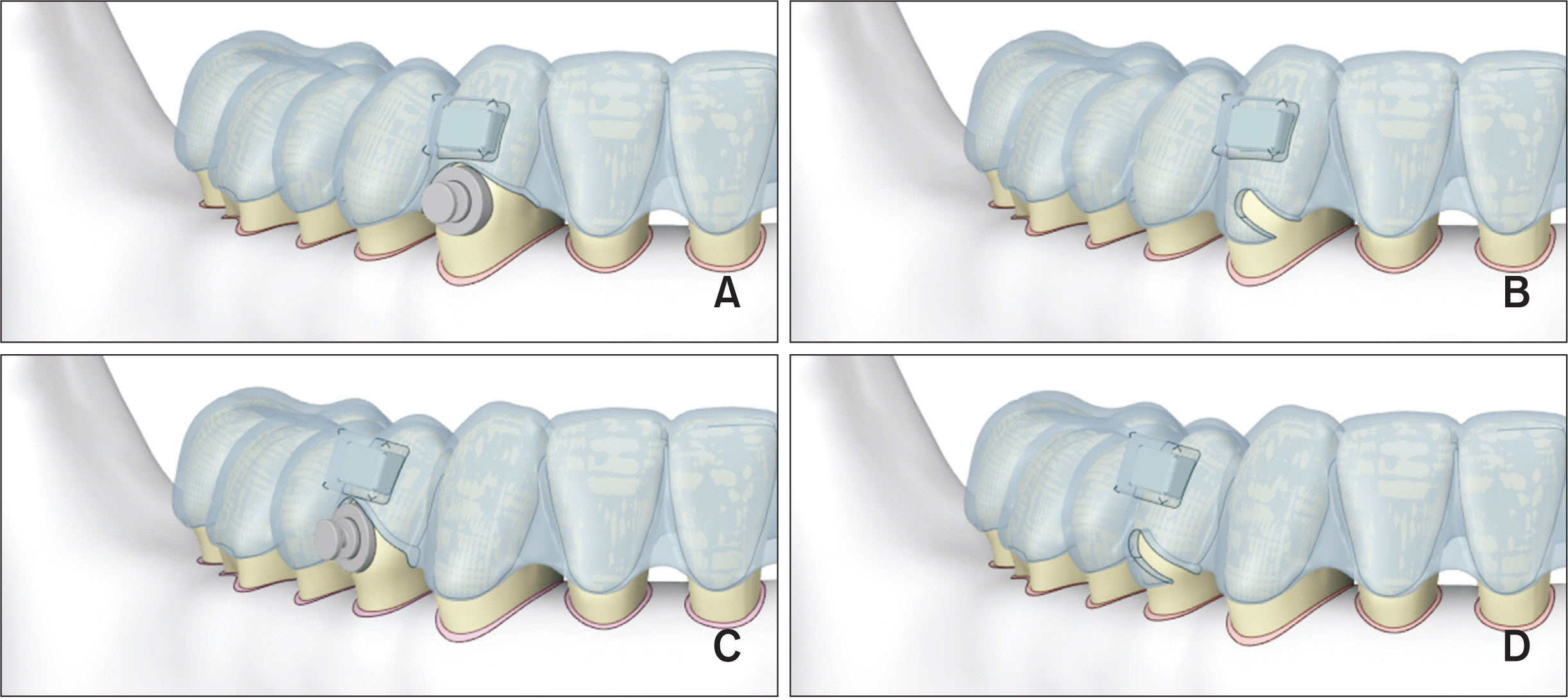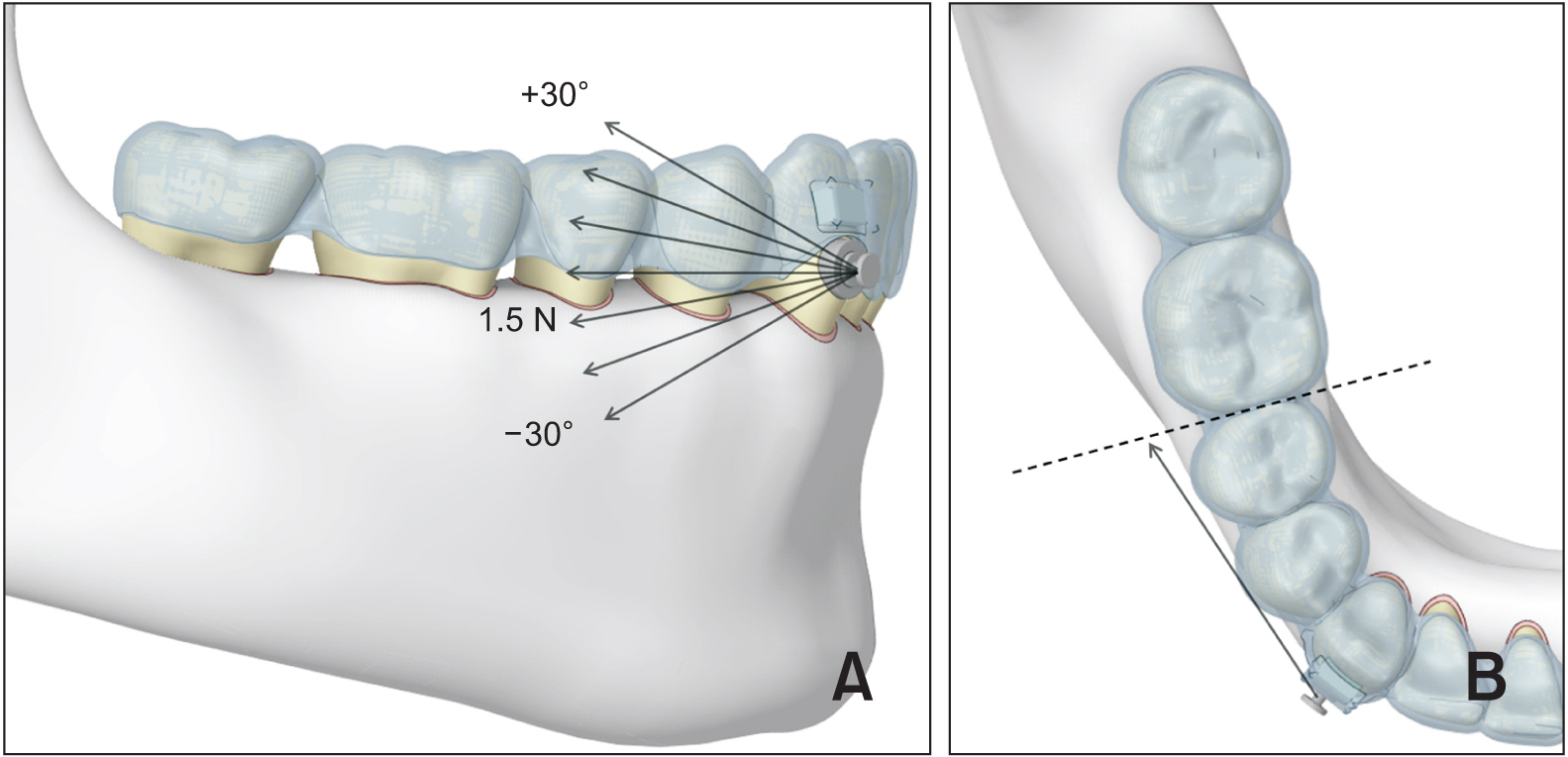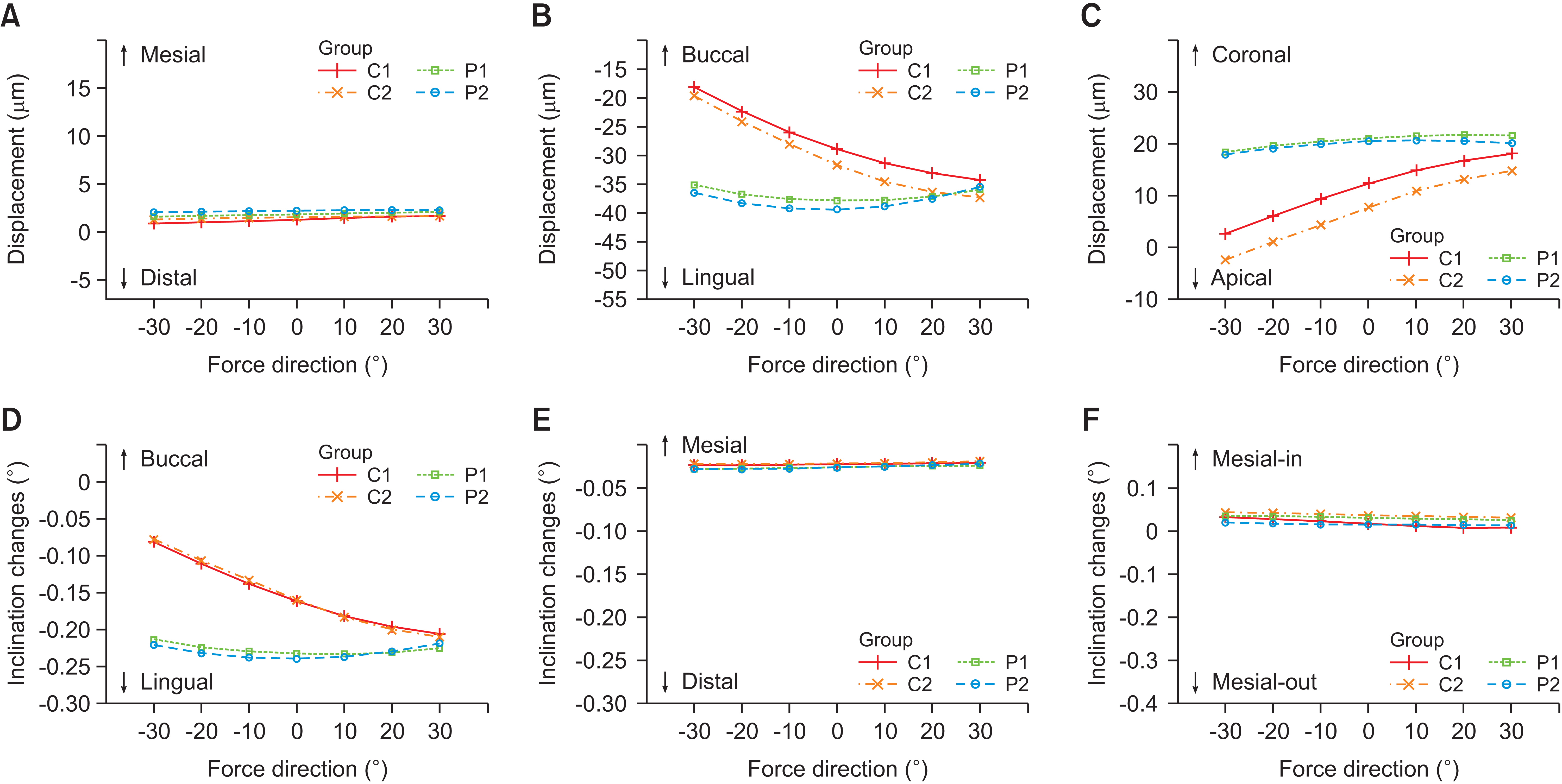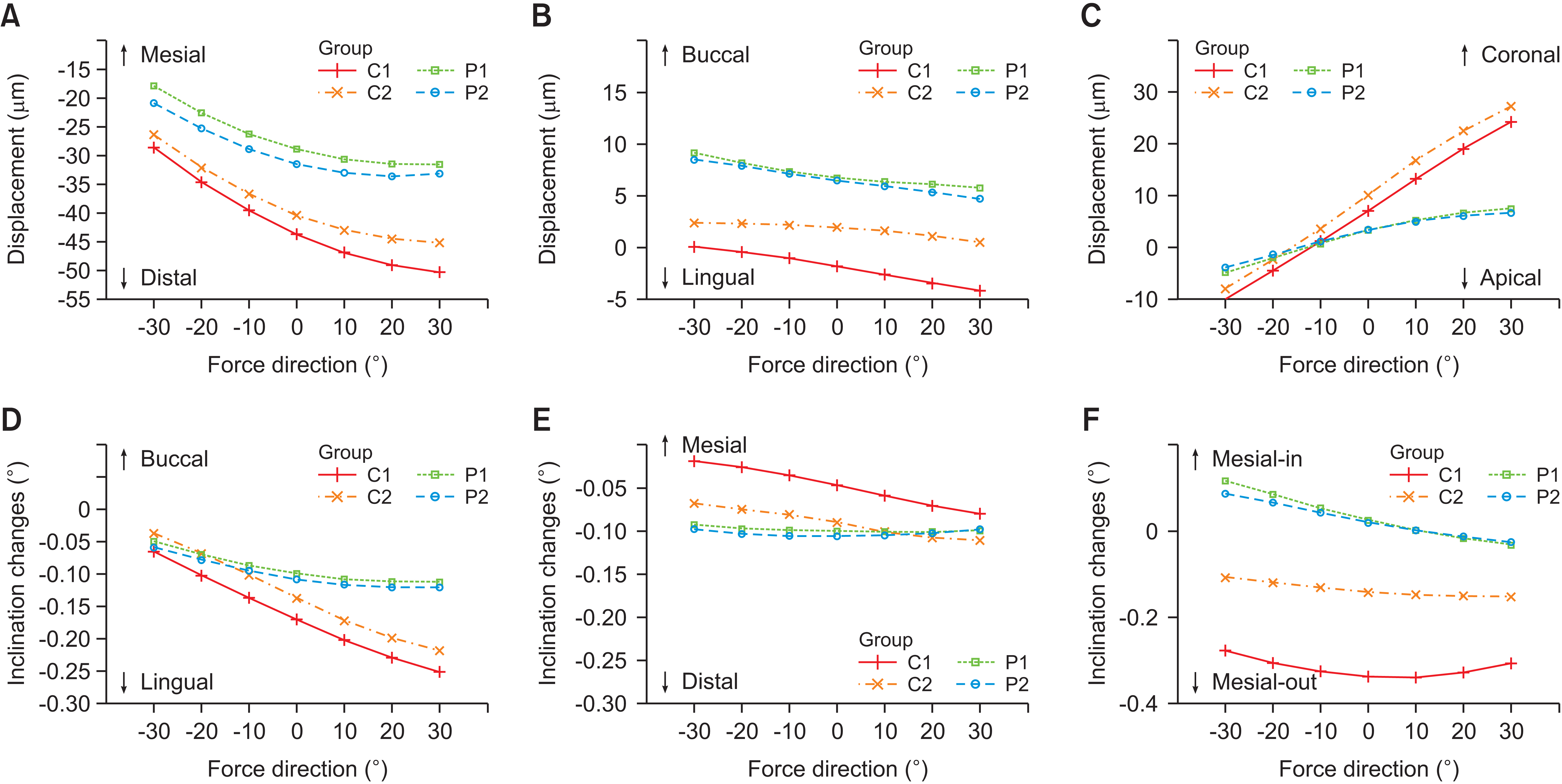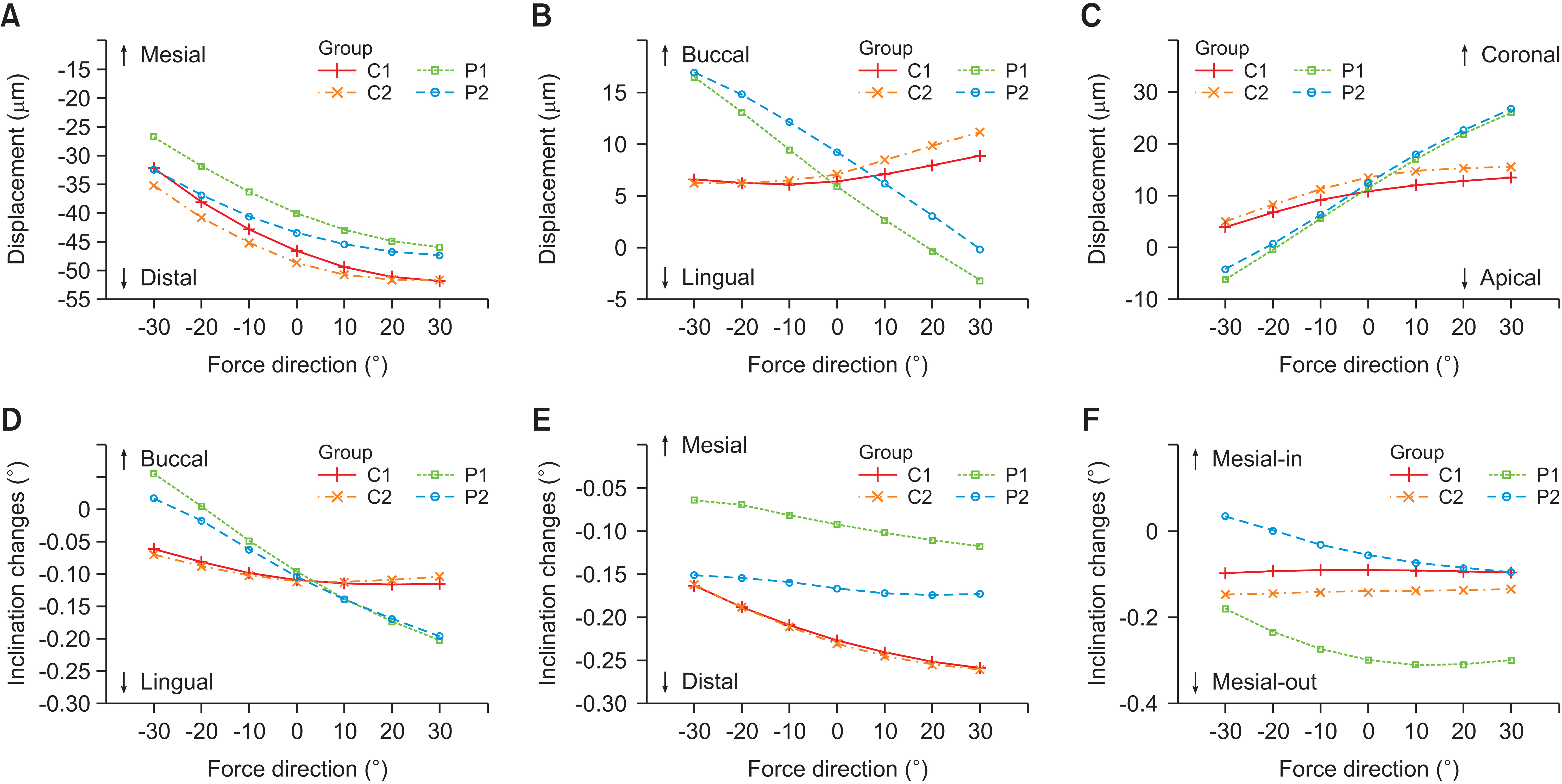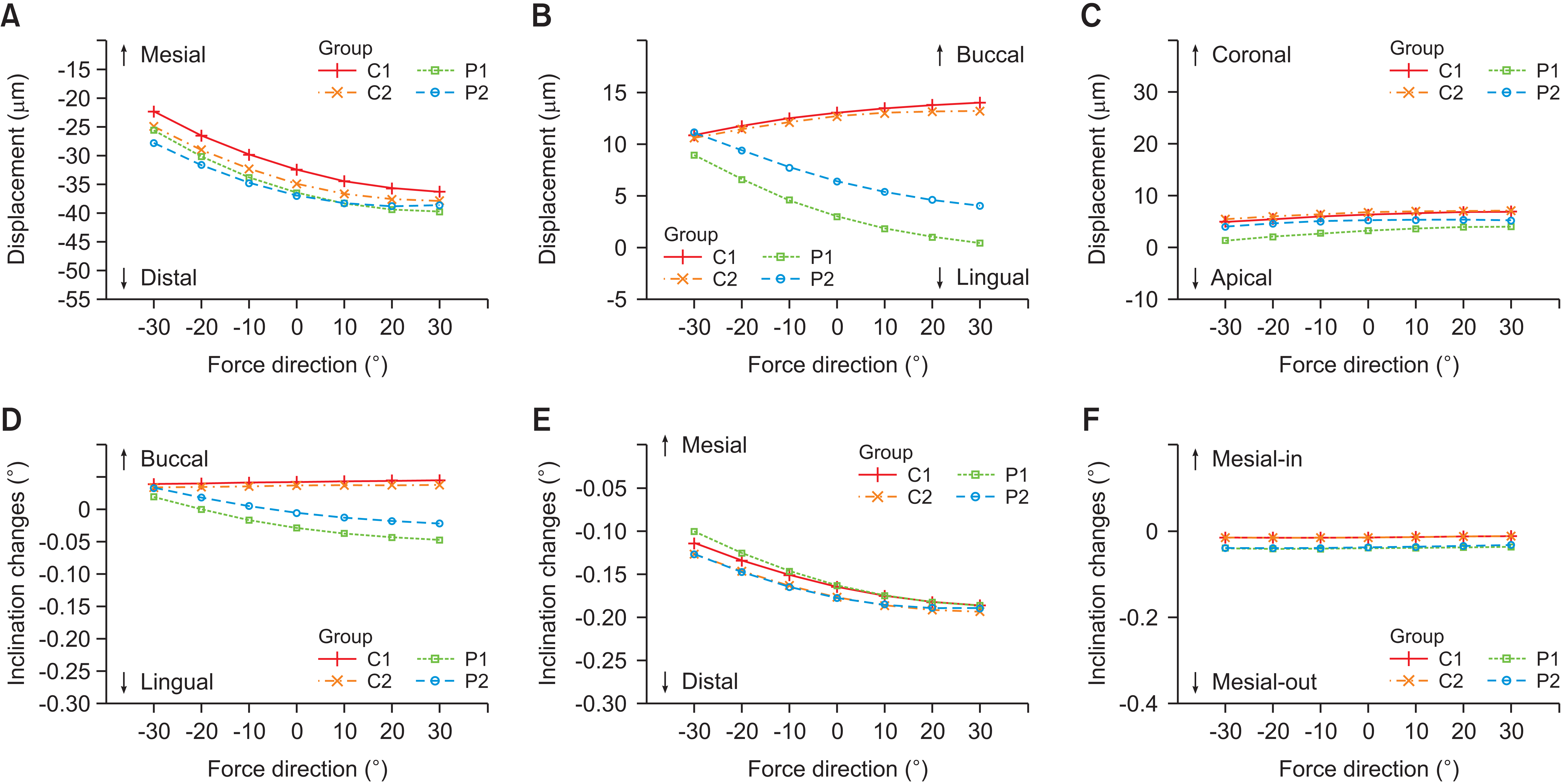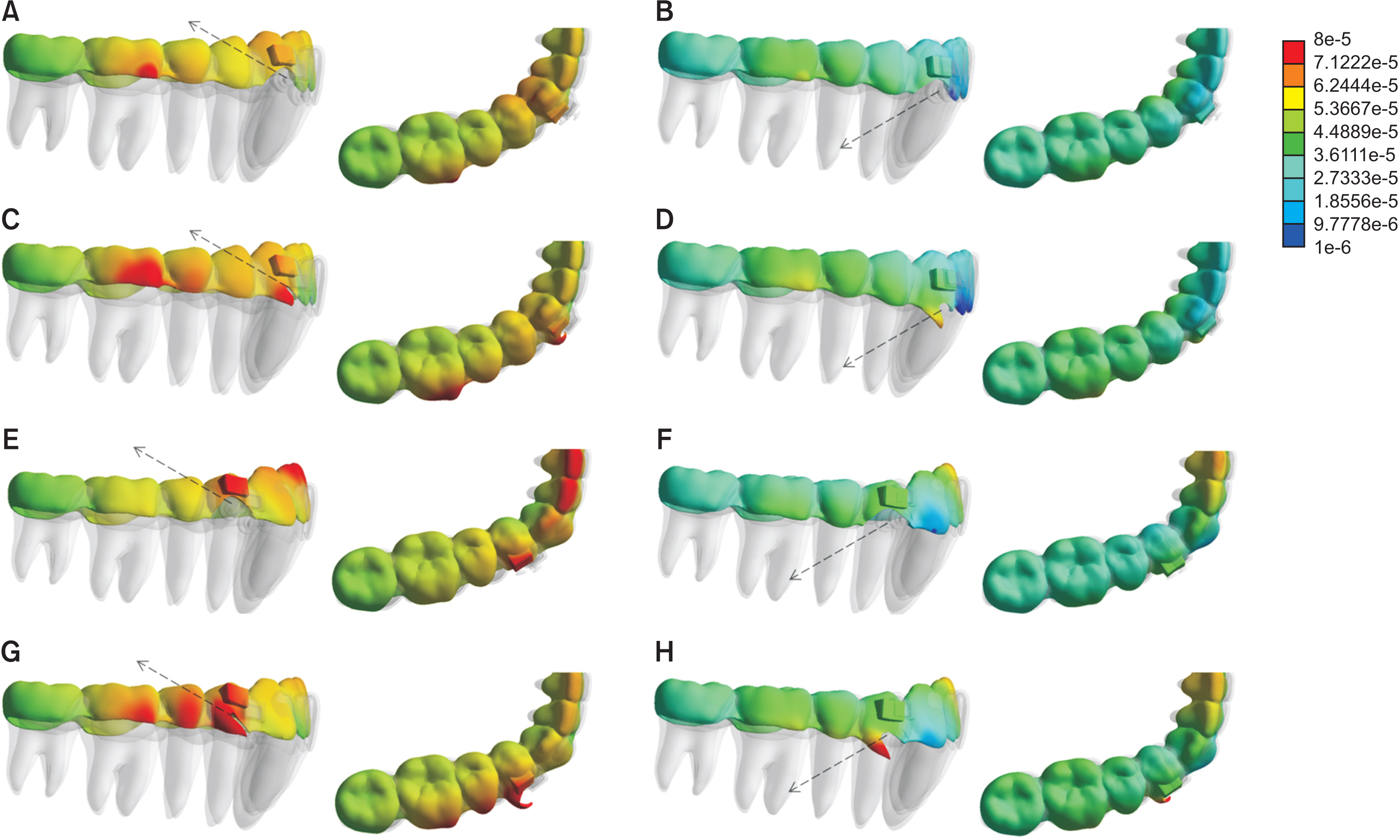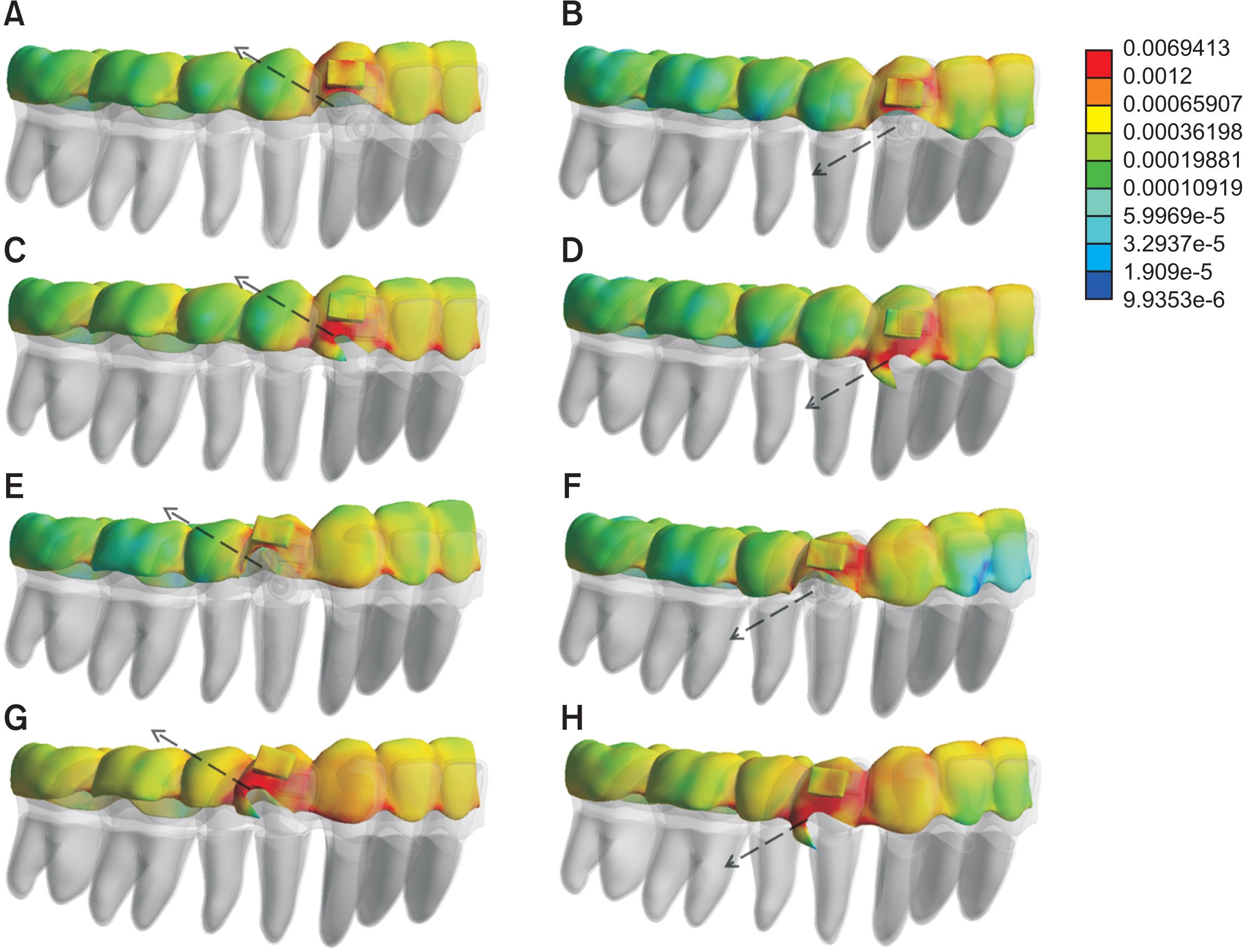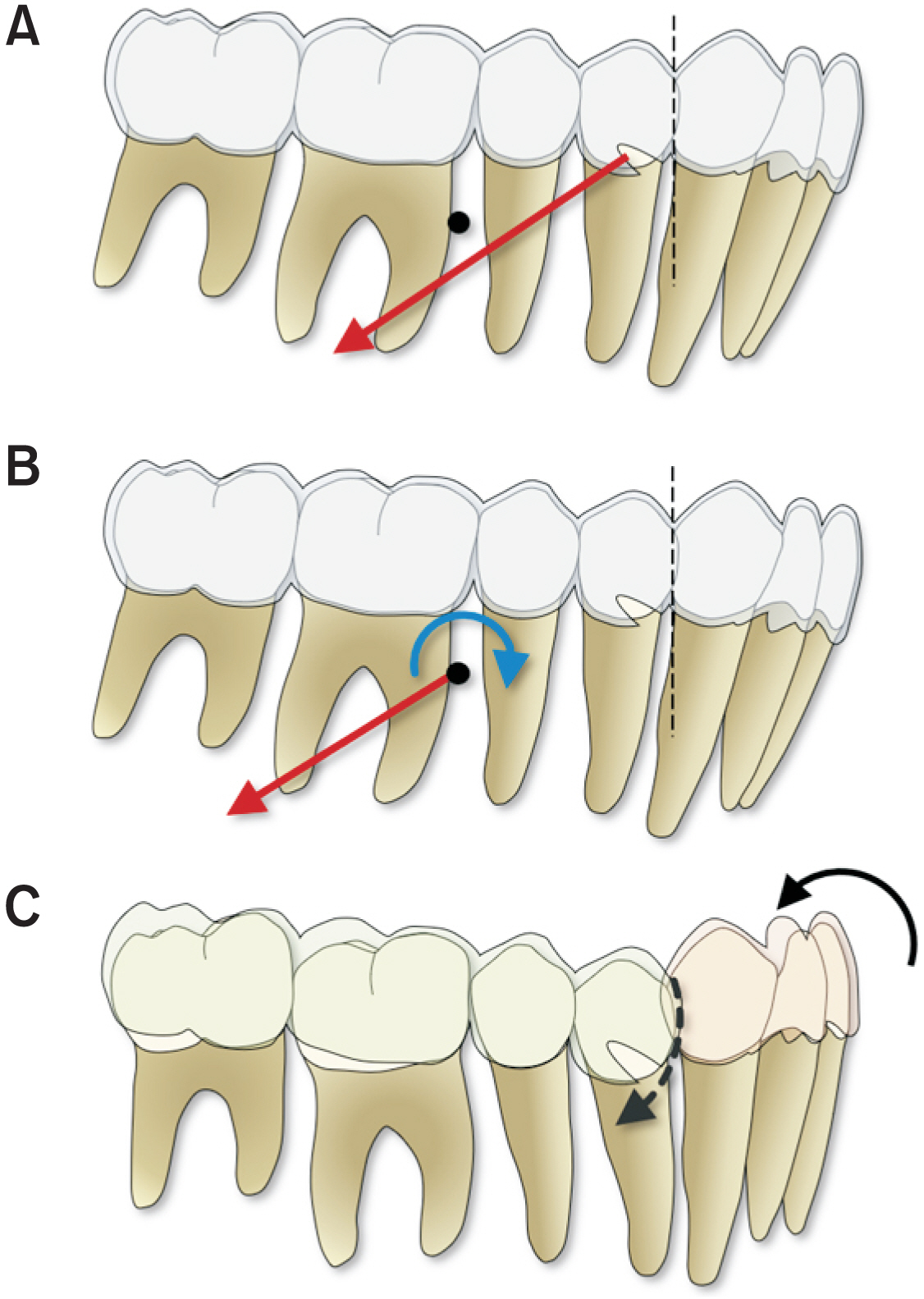Korean J Orthod.
2023 Nov;53(6):420-430. 10.4041/kjod23.035.
Biomechanical analysis for different mandibular total distalization methods with clear aligners: A finite element study
- Affiliations
-
- 1Department of Orthodontics, Dental Research Institute, Pusan National University Dental Hospital, Yangsan, Korea
- 2Department of Orthodontics, Pusan National University Hospital, Busan, Korea
- 3Division of Orthodontics, College of Dentistry, The Ohio State University, Columbus, OH, USA
- 4Department of Orthodontics, Saint Louis University, Saint Louis, Mo, USA
- 5Dental and Life Science Institute, School of Dentistry, Pusan National University, Yangsan, Korea
- KMID: 2548485
- DOI: http://doi.org/10.4041/kjod23.035
Abstract
Objective
The purpose of this finite element method (FEM) study was to analyze the biomechanical differences and tooth displacement patterns according to the traction direction, methods, and sites for total distalization of the mandibular dentition using clear aligner treatment (CAT).
Methods
A finite element analysis was performed on four FEM models using different traction methods (via a precision cut hook or button) and traction sites (mandibular canine or first premolar). A distalization force of 1.5 N was applied to the traction site by changing the direction from –30 to +30° to the occlusal plane. The initial tooth displacement and von Mises stress on the clear aligners were analyzed.
Results
All CAT-based total distalization groups showed an overall trend of clockwise or counterclockwise rotation of the occlusal plane as the force direction varied. Mesiodistal tipping of individual teeth was more prominent than that of bodily movements. The initial displacement pattern of the mandibular teeth was more predominant based on the traction site than on the traction method. The elastic deformation of clear aligners is attributed to unintentional lingual tipping or extrusion of the mandibular anterior teeth.
Conclusions
The initial tooth displacement can vary according to different distalization strategies for CAT-based total distalization. Discreet application and biomechanical understanding of traction sites and directions are necessary for appropriate mandibular total distalization.
Keyword
Figure
Reference
-
1. Proffit W, Fields H, Larson B, Sarver D. 2018. Contemporary orthodontics. 6th ed. Elsevier;Maryland Height: https://shop.elsevier.com/books/contemporary-orthodontics/proffit/978-0-323-54387-3. DOI: 10.1053/j.sodo.2018.10.005.2. Baik H. 2007; Limitations in orthopedic and camouflage treatment for Class III malocclusion. Semin Orthod. 13:158–74. https://doi.org/10.1053/j.sodo.2007.05.004. DOI: 10.1053/j.sodo.2007.05.004.
Article3. Burns NR, Musich DR, Martin C, Razmus T, Gunel E, Ngan P. 2010; Class III camouflage treatment: what are the limits? Am J Orthod Dentofacial Orthop. 137:9.e1–9.e13. discussion 9–11. https://doi.org/10.1016/j.ajodo.2009.05.017. DOI: 10.1016/j.ajodo.2009.05.017. PMID: 20122418.
Article4. Ngan P, Moon W. 2015; Evolution of Class III treatment in orthodontics. Am J Orthod Dentofacial Orthop. 148:22–36. https://doi.org/10.1016/j.ajodo.2015.04.012. DOI: 10.1016/j.ajodo.2015.04.012. PMID: 26124025.
Article5. Kim YH. 1987; Anterior openbite and its treatment with multiloop edgewise archwire. Angle Orthod. 57:290–321. https://pubmed.ncbi.nlm.nih.gov/3479033/. DOI: 10.1043/0003-3219(1987)057<0290:AOAITW>2.0.CO;2. PMID: 3479033.6. Ngan P, Sung JH. Nanda R, editor. 2015. Treatment strategies for developing and nondeveloping Class III malocclusions. Esthetics and biomechanics in orthodontics. 2nd ed. WB Saunders;Philadelphia: https://doi.org/10.1016/B978-1-4557-5085-6.00014-X. DOI: 10.1016/B978-1-4557-5085-6.00014-X.
Article7. Roberts WE, Viecilli RF, Chang C, Katona TR, Paydar NH. 2015; Biology of biomechanics: finite element analysis of a statically determinate system to rotate the occlusal plane for correction of a skeletal Class III open-bite malocclusion. Am J Orthod Dentofacial Orthop. 148:943–55. https://doi.org/10.1016/j.ajodo.2015.10.002. DOI: 10.1016/j.ajodo.2015.10.002. PMID: 26672700.
Article8. Chae JM, Park JH, Kojima Y, Tai K, Kook YA, Kyung HM. 2019; Biomechanical analysis for total distalization of the mandibular dentition: a finite element study. Am J Orthod Dentofacial Orthop. 155:388–97. https://doi.org/10.1016/j.ajodo.2018.05.014. DOI: 10.1016/j.ajodo.2018.05.014. PMID: 30826042.
Article9. Kim TW, Echarri P. 2007; Clear aligner: an efficient, esthetic, and comfortable option for an adult patient. World J Orthod. 8:13–8. https://pubmed.ncbi.nlm.nih.gov/17373221/. PMID: 17373221.10. Shalish M, Cooper-Kazaz R, Ivgi I, Canetti L, Tsur B, Bachar E, et al. 2012; Adult patients' adjustability to orthodontic appliances. Part I: a comparison between Labial, Lingual, and Invisalign™. Eur J Orthod. 34:724–30. https://doi.org/10.1093/ejo/cjr086. DOI: 10.1093/ejo/cjr086. PMID: 21750242.
Article11. Yezdani AA. 2015; Transparent aligners: an invisible approach to correct mild skeletal class III malocclusion. J Pharm Bioallied Sci. 7(Suppl 1):S301–6. https://doi.org/10.4103/0975-7406.155965. DOI: 10.4103/0975-7406.155965. PMID: 26015738. PMCID: PMC4439698. PMID: 9a644e12fb20423f9abcb4721e4f9f55.
Article12. Nanda R, Uribe FA, Yadav S. 2020. Temporary anchorage devices in orthodontics. 2nd ed. Elsevier;Maryland Heights: https://shop.elsevier.com/books/temporary-anchorage-devices-in-orthodontics/nanda/978-0-323-60933-3. DOI: 10.1016/c2017-0-02979-8.13. Rota E, Parrini S, Malekian K, Cugliari G, Mampieri G, Deregibus A, et al. 2022; Lower molar distalization using clear aligners: bodily movement or uprighting? A preliminary study. Appl Sci. 12:7123. https://doi.org/10.3390/app12147123. DOI: 10.3390/app12147123. PMID: 0dd996d1423c4b55b612e97b3728fd33.14. Gomez JP, Peña FM, Martínez V, Giraldo DC, Cardona CI. 2015; Initial force systems during bodily tooth movement with plastic aligners and composite attachments: a three-dimensional finite element analysis. Angle Orthod. 85:454–60. https://doi.org/10.2319/050714-330.1. DOI: 10.2319/050714-330.1. PMID: 25181252. PMCID: PMC8612436.15. Upadhyay M, Arqub SA. 2022; Biomechanics of clear aligners: hidden truths & first principles. J World Fed Orthod. 11:12–21. https://doi.org/10.1016/j.ejwf.2021.11.002. DOI: 10.1016/j.ejwf.2021.11.002. PMID: 34965910.
Article16. Liu L, Zhan Q, Zhou J, Kuang Q, Yan X, Zhang X, et al. 2021; Effectiveness of an anterior mini-screw in achieving incisor intrusion and palatal root torque for anterior retraction with clear aligners. Angle Orthod. 91:794–803. https://doi.org/10.2319/120420-982.1. DOI: 10.2319/120420-982.1. PMID: 34061964. PMCID: PMC8549549.
Article17. Comba B, Parrini S, Rossini G, Castroflorio T, Deregibus A. 2017; A three-dimensional finite element analysis of upper-canine distalization with clear aligners, composite attachments, and Class II elastics. J Clin Orthod. 51:24–8. https://pubmed.ncbi.nlm.nih.gov/28253487/. PMID: 28253487.18. Rossini G, Modica S, Parrini S, Deregibus A, Castroflorio T. 2021; Incisors extrusion with clear aligners technique: a finite element analysis study. Appl Sci. 11:1167. https://doi.org/10.3390/app11031167. DOI: 10.3390/app11031167. PMID: 51c1fcdd298d49b6bffe6415c4a5d7be.
Article19. Cortona A, Rossini G, Parrini S, Deregibus A, Castroflorio T. 2020; Clear aligner orthodontic therapy of rotated mandibular round-shaped teeth: a finite element study. Angle Orthod. 90:247–54. https://doi.org/10.2319/020719-86.1. DOI: 10.2319/020719-86.1. PMID: 31469592. PMCID: PMC8051248.
Article20. Kawamura J, Tamaya N. 2019; A finite element analysis of the effects of archwire size on orthodontic tooth movement in extraction space closure with miniscrew sliding mechanics. Prog Orthod. 20:3. https://doi.org/10.1186/s40510-018-0255-8. DOI: 10.1186/s40510-018-0255-8. PMID: 30663006. PMCID: PMC6339866. PMID: 00accc94414f46dba4471693b45f4ac0.
Article21. Cattaneo PM, Dalstra M, Melsen B. 2005; The finite element method: a tool to study orthodontic tooth movement. J Dent Res. 84:428–33. https://doi.org/10.1177/154405910508400506. DOI: 10.1177/154405910508400506. PMID: 15840778.
Article22. Tai S. 2018. Clear aligner technique. Quintessence;Batavia: https://www.amazon.com/Clear-Aligner-Technique-Sandra-Tai/dp/0867157771. DOI: 10.1016/j.ajodo.2018.09.002.23. Eliades T, Athanasiou AE. 2021. Orthodontic aligner treatment. Thieme;New York: https://shop.thieme.com/Orthodontic-Aligner-Treatment/9783132411487. DOI: 10.1038/s41415-021-2706-8.24. Chan E, Darendeliler MA. 2017; The Invisalign® appliance today: a thinking person's orthodontic appliance. Semin Orthod. 23:12–64. https://doi.org/10.1053/j.sodo.2016.10.003. DOI: 10.1053/j.sodo.2016.10.003.
Article25. Kawamura J, Park JH, Kojima Y, Tamaya N, Kook YA, Kyung HM, et al. 2021; Biomechanical analysis for total mesialization of the maxillary dentition: a finite element study. Am J Orthod Dentofacial Orthop. 159:790–8. https://doi.org/10.1016/j.ajodo.2020.02.021. DOI: 10.1016/j.ajodo.2020.02.021. PMID: 33736907.
Article26. Brezniak N. 2008; The clear plastic appliance: a biomechanical point of view. Angle Orthod. 78:381–2. https://pubmed.ncbi.nlm.nih.gov/18251593/. DOI: 10.2319/0003-3219(2008)078[0381:TCPA]2.0.CO;2. PMID: 18251593.27. Upadhyay M, Shah R, Peterson D, Asaki T, Yadav S, Agarwal S. 2017; Force system generated by elastic archwires with vertical V bends: a three-dimensional analysis. Eur J Orthod. 39:202–8. https://doi.org/10.1093/ejo/cjw044. DOI: 10.1093/ejo/cjw044. PMID: 27287313. PMCID: PMC6279105.
Article
- Full Text Links
- Actions
-
Cited
- CITED
-
- Close
- Share
- Similar articles
-
- Biomechanical analysis of distalization of mandibular molars by placing a mini-plate: A finite element study
- Evaluation of the effects of the third molar on distalization and the effects of attachments on distalization and expansion with clear aligners: Three-dimensional finite element study
- Three-dimensional finite element analysis of implant-supported crown in fibula bone model
- Comparison of the outcomes of three-dimensional finite element analysis under arbitrary and realistic occlusal loading conditions in mandibular posterior region
- Three dimensional finite element analysis of mandibular stresses of complete denture occlusion

